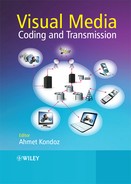3.5 Conclusions
In this chapter, contributions relating to scalable video coding have been described in the framework of VISNET. Virtual collaboration videoconferencing is one of the applications and scenarios presented. Advances of scalable video coding for 3D video applications were discussed in the three categories given below.
First, a highly-scalable 2D-model-based video coding technique was investigated and its application for depth map sequence coding was also studied. The objective of scalable coding of shape, texture, and depth for 3D video is to improve the coding efficiency of 3D video content. Some algorithms have been proposed for scalable shape coding, scalable texture coding, and scalable depth coding. Promising results have been obtained. Extensive experiments have been conducted to verify the efficiency of our proposed method for both texture and depth coding, and to compare it with the standard coding tools such as MPEG-4 and H.264.
Second, the adaptation of scalable video coding for stereoscopic 3D video applications were also presented. The work analyzed the rate-distortion performance of stereoscopic video using three configurations based on MPEG-4 MAC, H.264/AVC, and SVC. The proposed SVC configuration, based on the layered architecture, performs similarly to the configuration based on H.264/AVC and outperforms the configuration based on MPEG-4 MAC at all bit rates in terms of objective and subjective quality. Furthermore, the configuration based on SVC produces high-quality stereoscopic video using color and depth sequences (obtained from the depth–range camera) compared to the virtual left and right sequences produced from the same color and depth sequences at low bit rates.
Third, 3D wavelet-based approaches towards scalable video coding were acknowledged. Several research activities have focused on the design of efficient 3D wavelet coders in the last few years. This has led to coding architectures that have coding efficiency similar to the state-of-the-art non-scalable video coder H.264/AVC, while adding scalability as an additional feature. Despite the fact that other coding schemes are able to offer scalability, 3D wavelet coders are characterized by an unmatched degree of flexibility. The MPEG Ad Hoc Group on Scalable Video Coding investigated the use of wavelet-based approaches as the basis for the future MPEG-21 standard. Although it is not clear yet whether a full-3D wavelet-based scheme will be adopted, motion-compensated temporal filtering will definitively be the core coding tool of that standard. Recent studies on longer temporal kernels and adaptive t + 2D/2D + t schemes seem to prove that further improvements are on their way.
Error robustness techniques for scalable video and image coding developed within VISNET have also been described in this chapter. First, an error-robustness method for key frames in scalable video coding was proposed. This technique employs correlated frames, i.e. the redundant data resulting from key frames of two consecutive GOP structures. The proposed error-robustness technique is of particular benefit for fast-motion sequences, as categorized in Class C. The reasons are twofold: (1) additional bit overhead for the correlated frame is relatively insignificant;(2) the missing key frame is always unable to be compensated by simple frame copy. The simulations place emphasis on examining the performance of correlated frames in Class C sequences. The results show the advantages over the JSVM frame-copy strategy in terms of error robustness for error-prone channel transmission, as well as error concealment at the decoder side.
Second, a standard compliance scalable MDC scheme based on even and odd frames was proposed for the H.264/SVC targeting 3D videoconferencing applications. The proposed algorithm generates two descriptions for the base layer of SVC, based on even and odd frame separation, which reduces its coding efficiency compared to SDC. However, in an ideal MDC channel the proposed scheme achieves good quality even if only one of the descriptions is received. Objective and 2D/3D subjective evaluation in an error-prone WiMax channel shows an improved performance of the proposed algorithm at high error rates when compared to SDC. The proposed scheme can provide scalability and 3D video communication for the videoconferencing component of the virtual collaboration system.
Third, and finally in this chapter, the general issue of error resilience in scalable video coding based on JPEG 2000 was analyzed and the ongoing JPWL standardization effort was reviewed. The goal of JPWL is to define an extension of the JPEG 2000 baseline specification in order to enable the efficient transmission of JPEG 2000 codestream over an error-prone network. The performance of the JPWL error-protection block (EPB) tool was also evaluated. Two configurations of EPB were considered: to protect the main and tile-part headers, and to protect the whole codestream using unequal error protection (UEP). Experimental results showed a significant quality improvement when using UEP. Gains up to 3.57 dB have been obtained when compared to JPEG 2000 baseline without error resilience, and up to 1.85 dB against baseline with error-resilience tools.
